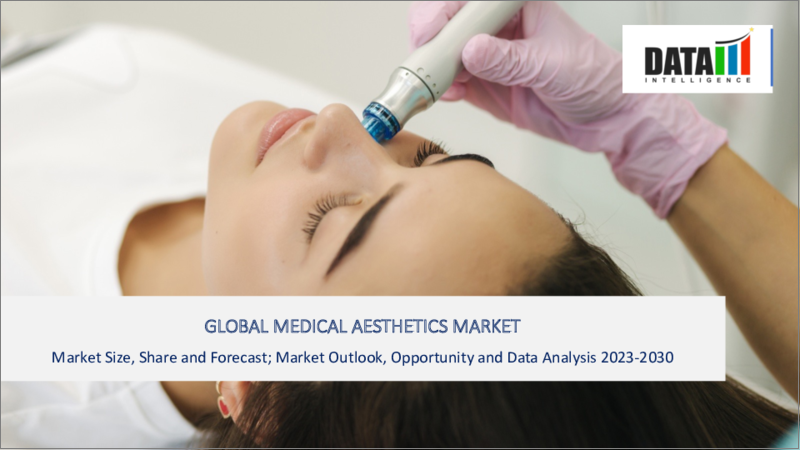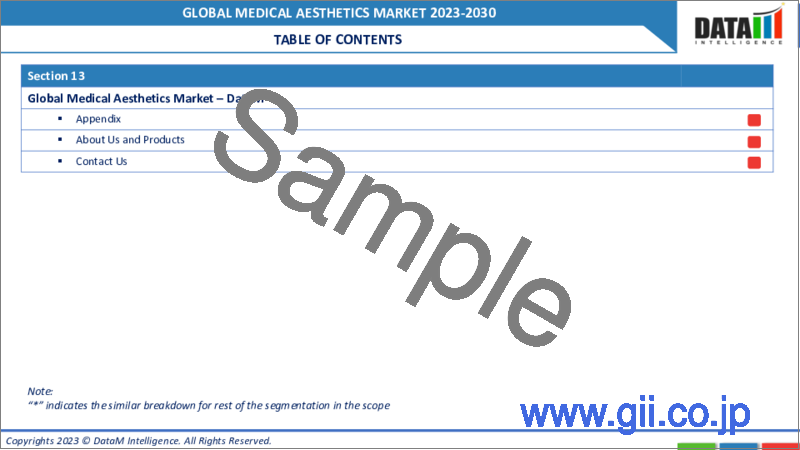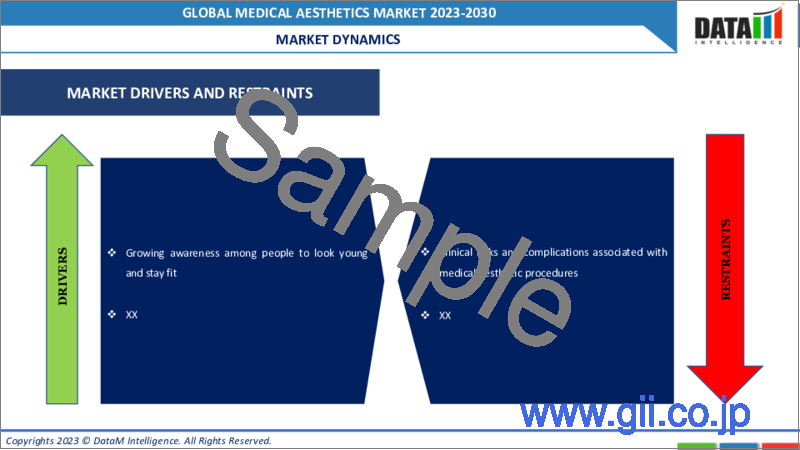|
|
市場調査レポート
商品コード
1297777
美容医療の世界市場-2023年~2030年Global Medical Aesthetics Market - 2023-2030 |
||||||
カスタマイズ可能
適宜更新あり
|
|||||||
| 美容医療の世界市場-2023年~2030年 |
|
出版日: 2023年06月15日
発行: DataM Intelligence
ページ情報: 英文 195 Pages
納期: 即日から翌営業日
|
- 全表示
- 概要
- 目次
市場概要
世界の美容医療市場規模は、2022年に137億米ドルに達し、2030年には325億米ドルに達する好成長が予測されています。予測期間2023-2030年のCAGRは11.8%です。
美容医療市場は、美意識の高まり、高齢化、技術の進歩、医療ツーリズムの拡大、予防美容へのシフト、安全性と有効性のプロファイルの改善などが牽引しています。
美容医療市場には、施術費用の高さ、規制環境、美容医療に伴う副作用、安全性への懸念、熟練した専門家の不足、社会的烙印と認識、保険適用範囲の制限、文化的・倫理的配慮、特定の施術の安全性と有効性に関する長期的データの不足などの抑制要因があります。
市場力学
美容意識の高まり
個人の美意識の高まりは、美容医療市場の成長の大きな原動力となっています。個人の外見を重視し投資する文化的な変化があり、多くの人々が自然な特徴を強化したり、特定の美的懸念に対処することを求めています。
ソーシャルメディアやスマートフォンの普及、技術の進歩、低侵襲または非侵襲の施術の利用可能性など、いくつかの要因が人々の魅力に対する認識に影響を与えています。さらに、美意識の高まりは、美容医療市場の成長を向上させる大きな要因となっています。
施術の高額費用
美容医療施術の高額な費用は市場成長に大きく影響します。費用は施術の種類、地域、施術者の専門知識、特定のクリニックや施設によって異なります。美容医療施術の高価格は、その施術が手の届かないものであると感じる一部の人々にとって、アクセスの障壁となりうる。しかし、こうした施術の費用は、多くの場合、その品質、専門知識、安全対策、高度な技術を反映していることを考慮することが重要です。
近年、市場では、美容医療をより利用しやすく、手ごろな価格にしようとする努力が見られます。これには、融資オプションの利用可能性、パッケージ契約、ロイヤリティ・プログラム、競合価格を提供する専門クリニックの出現などが含まれます。さらに、市場が成長し進化し続けるにつれて、進歩や革新が将来的にコストを引き下げる可能性もあります。
COVID-19影響分析
COVID-19の流行は、美容医療市場に大きな影響を与えています。パンデミックの初期段階では、多くの美容クリニックや医療スパが一時的に閉鎖されたり、制限付きで営業されました。パンデミックは消費者の優先順位や経済状況に変化をもたらしました。医療&美容業界は、COVID-19感染のリスクを最小限に抑えるため、厳格な安全・衛生プロトコルに適応しなければならなかっています。
パンデミック関連の規制が緩和され、ワクチン接種キャンペーンが進むにつれて、美容医療市場は回復し始めました。審美治療に対する需要の高まりと、外見に関する悩みに対処したいという願望が、市場の復活に貢献しました。長時間のリモートワークやテレビ会議、マスクの使用で外見をリフレッシュしたいというニーズが高まっています。全体として、市場はパンデミック後に回復しつつあります。
ロシア・ウクライナ紛争分析
ロシアとウクライナの紛争は、医療施設やクリニックを含むヘルスケア・インフラを破壊し、この地域の美容医療市場に大きな影響を与えました。この戦争が化粧品に及ぼす長期的な影響と、ロシア・ウクライナ戦争中にウクライナの学術・医学・科学分野における研究の機会を逃したことについてのリスク。
目次
第1章 調査手法と調査範囲
第2章 定義と概要
第3章 エグゼクティブサマリー
第4章 市場力学
- 影響要因
- 促進要因
- 美容意識の高まり
- 抑制要因
- 施術費用の高さ
- 機会
- 影響分析
- 促進要因
第5章 産業分析
- ポーターの5フォース分析
- サプライチェーン分析
- 価格分析
- 規制分析
第6章 COVID-19分析
第7章 製品別
- ボディコンツアーデバイス
- 美容レーザー
- スキンタイトニング機器
- 美顔器
- ボトックス
- ケミカルピーリング
- 皮膚フィラー
- インプラント
- 乳房インプラント
- シリコンジェル充填インプラント
- 生理食塩水充填
- 凝集性半固形インプラント
- 顔面インプラント
- 乳房インプラント
- その他
第8章 用途別
- カーボンピーリング
- タトゥー除去
- スキンリサーフェシング
- 脱毛
- 傷跡治療
- その他
第9章 エンドユーザー別
- 病院
- 皮膚科クリニック
- メディカル・スパ
- 美容センター
第10章 地域別
- 北米
- 米国
- カナダ
- メキシコ
- 欧州
- ドイツ
- 英国
- フランス
- イタリア
- スペイン
- その他欧州
- 南米
- ブラジル
- アルゼンチン
- その他南米
- アジア太平洋
- 中国
- インド
- 日本
- オーストラリア
- その他アジア太平洋地域
- 中東・アフリカ
第11章 競合情勢
- 競合シナリオ
- 市況/シェア分析
- M&A分析
第12章 企業プロファイル
- Allergan plc
- 会社概要
- 製品ポートフォリオと説明
- 財務概要
- 主な発展
- Alma Lasers Ltd.
- Cutera Inc.
- Cynosure
- Fotona d.o.o.
- Merz Pharma GmbH & Co.
- Sientra Inc.
- Sinclair Pharma PLC
- Syneron Medical Ltd.
- Bausch Health Companies Inc.
第13章 付録
Market Overview
The Global Medical Aesthetics Market size reached US$ 13.7 billion in 2022 and is projected to witness lucrative growth by reaching up to US$ 32.5 billion by 2030. The market is exhibiting at a CAGR of 11.8% during the forecast period 2023-2030.
The medical aesthetics market is driven by increasing beauty consciousness, the aging population, technological advancements, growing medical tourism, shifting towards preventive aesthetics, and improved safety and efficacy profiles.
The medical aesthetics market has some restraints, such as the high cost of procedures, regulatory environment, side effects associated with medical aesthetics, safety concerns, lack of skilled professionals, social stigma and perception, limited insurance coverage, cultural and ethical considerations, and lack of long-term data on the safety and efficacy of certain treatments and so on.
Market Dynamics
Increasing Beauty Consciousness
The increasing beauty consciousness among individuals has been a significant driver of growth in the medical aesthetics market. There has been a cultural shift towards valuing and investing in personal appearance, with many people seeking to enhance their natural features or address specific aesthetic concerns.
Several factors such as social media and the widespread use of smartphones, advancements in technology, and the availability of minimally invasive or non-invasive procedures influence people's perceptions of attractiveness. Furthermore, the increasing beauty consciousness is a major factor in improving the medical aesthetics market growth.
High Cost of the Procedures
The high cost of medical aesthetics procedures significantly impacts market growth. The cost varies depending on the type of procedure, geographic location, the practitioner's expertise, and the specific clinic or facility. The high price of medical aesthetics procedures can create barriers to access for some individuals who may find the treatments unaffordable. However, it is important to consider that the cost of these procedures often reflects the quality, expertise, safety measures, and advanced technology involved.
In recent years, the market has witnessed efforts to make medical aesthetics more accessible and affordable. This includes the availability of financing options, package deals, loyalty programs, and the emergence of specialized clinics that offer competitive pricing. Additionally, as the market continues to grow and evolve, advancements and innovations may potentially drive down costs in the future.
COVID-19 Impact Analysis
The COVID-19 pandemic is significantly impacted the medical aesthetics market. Many aesthetic clinics and medical spas were temporarily closed or operated with restrictions during the initial phases of the pandemic. The pandemic brought about changes in consumer priorities and financial situations. The medical aesthetics industry had to adapt to stringent safety and hygiene protocols to minimize the risk of COVID-19 transmission.
As pandemic-related restrictions eased and vaccination campaigns progressed, the medical aesthetics market began to recover. The pent-up demand for aesthetic treatments and the desire to address appearance-related concerns contributed to a resurgence in the market. People sought to refresh their appearance after prolonged remote work, video conferencing, and mask usage. Overall, the market is recovering after the pandemic.
Russia-Ukraine Conflict Analysis
The Russia-Ukraine conflict between the two countries significantly impacted the medical aesthetics market in the region, disrupting healthcare infrastructure, including medical facilities and clinics; medical aesthetics procedures took a backseat as resources and attention were focused on more critical areas of healthcare. Risk about the war's long-term impact on cosmetics and the missed opportunities for research in Ukraine's academic, medical, and scientific disciplines during Russia Ukraine war.
Segment Analysis
The Global Medical Aesthetics Market is segmented based on product, application, end-user, and region.
Skin-tightening Devices in Product Segment will be Dominated in the Market by Capturing 37.1% Market Share During the Forecast Period.
Based on the product, skin-tightening devices are a popular and widely used category within the medical aesthetics market. These devices use various technologies, such as radiofrequency (RF), ultrasound, laser, or infrared, to stimulate collagen production and improve skin firmness and tightness. Skin-tightening treatments are sought by individuals looking to address sagging skin, wrinkles, and overall skin laxity.
Skin-tightening devices offer a non-surgical or minimally invasive alternative to surgical procedures like facelifts. Many prefer these non-invasive options as they involve little to no downtime, carry fewer risks, and do not require incisions or anesthesia. The devices have seen significant advancements in recent years, enhancing their effectiveness and safety. energy delivery, precision targeting, and temperature control have contributed to better treatment outcomes and patient satisfaction.
Geographical Analysis
North America Accounted for Approximately 41.3% of the Market Share in 2022 due to advanced healthcare infrastructure.
North America, particularly the United States, has a well-developed healthcare system with advanced medical facilities and a strong network of clinics, hospitals, and aesthetic centers. These facilities offer a wide range of medical aesthetics treatments and have access to state-of-the-art technologies and equipment.
North America is a hub for technological innovation, including advancements in medical aesthetics. The region has been at the forefront of developing and adopting new technologies, such as laser devices, energy-based treatments, and advanced injectables. These technological advancements attract patients and contribute to the growth of the market.
Competitive Landscape
The major global players in the market include: Allergan plc, Alma Lasers Ltd., Cutera Inc., Cynosure, Fotona d.o.o, Merz Pharma GmbH & Co., Sientra Inc., Sinclair Pharma PLC, Syneron Medical Ltd., and Bausch Health Companies Inc.
Why Purchase the Report?
- To visualize the Global Medical Aesthetics Market segmentation based on product, application, end-user, and region and understand key commercial assets and players.
- Identify commercial opportunities by analyzing trends and co-development.
- Excel data sheet with numerous medical aesthetics market-level data points with all segments.
- PDF report consists of a comprehensive analysis after exhaustive qualitative interviews and an in-depth study.
- Product mapping available as Excel consisting of key products of all the major players.
The Global Medical Aesthetics Market Report Would Provide Approximately 54 Tables, 46 Figures And 195 pages.
Target Audience 2023
- Manufacturers/ Buyers
- Industry Investors/Investment Bankers
- Research Professionals
- Emerging Companies
Table of Contents
1. Methodology and Scope
- 1.1. Research Methodology
- 1.2. Research Objective and Scope of the Report
2. Definition and Overview
3. Executive Summary
- 3.1. Snippet by Product
- 3.2. Snippet by Application
- 3.3. Snippet by End-User
- 3.4. Snippet by Region
4. Dynamics
- 4.1. Impacting Factors
- 4.1.1. Drivers
- 4.1.1.1. Increasing beauty consciousness
- 4.1.2. Restraints
- 4.1.2.1. High cost of the procedure
- 4.1.3. Opportunity
- 4.1.4. Impact Analysis
- 4.1.1. Drivers
5. Industry Analysis
- 5.1. Porter's 5 Forces Analysis
- 5.2. Supply Chain Analysis
- 5.3. Pricing Analysis
- 5.4. Regulatory Analysis
6. COVID-19 Analysis
- 6.1. Analysis of COVID-19
- 6.1.1. Before COVID-19 Scenario
- 6.1.2. Present COVID-19 Scenario
- 6.1.3. Post COVID-19 or Future Scenario
- 6.2. Pricing Dynamics Amid COVID-19
- 6.3. Demand-Supply Spectrum
- 6.4. Government Initiatives Related to the Market During the Pandemic
- 6.5. Manufacturer's Strategic Initiatives
- 6.6. Conclusion
7. By Product
- 7.1. Introduction
- 7.1.1. Market Size Analysis and Y-o-Y Growth Analysis (%), By Product
- 7.1.2. Market Attractiveness Index, By Product
- 7.2. Body Contouring Devices*
- 7.2.1. Introduction
- 7.2.2. Market Size Analysis and Y-o-Y Growth Analysis (%)
- 7.3. Aesthetic Lasers
- 7.4. Skin Tightening Devices
- 7.5. Facial Aesthetic Devices
- 7.5.1. Botox
- 7.5.2. Chemical Peels
- 7.5.3. Dermal Fillers
- 7.6. Implants
- 7.6.1. Breast Implants
- 7.6.1.1. Silicone gel-filled Implants
- 7.6.1.2. Saline Filled
- 7.6.1.3. Cohesive Semi-solid Implants
- 7.6.2. Facial Implants
- 7.6.1. Breast Implants
- 7.7. Others
8. By Application
- 8.1. Introduction
- 8.1.1. Market Size Analysis and Y-o-Y Growth Analysis (%), By Application
- 8.1.2. Market Attractiveness Index, By Application
- 8.2. Carbon Peel*
- 8.2.1. Introduction
- 8.2.2. Market Size Analysis and Y-o-Y Growth Analysis (%)
- 8.3. Tattoo Removal
- 8.4. Skin Resurfacing
- 8.5. Hair Removal
- 8.6. Scar Treatment
- 8.7. Others
9. By End-User
- 9.1. Introduction
- 9.1.1. Market Size Analysis and Y-o-Y Growth Analysis (%), By End-User
- 9.1.2. Market Attractiveness Index, By End-User
- 9.2. Hospitals*
- 9.2.1. Introduction
- 9.2.2. Market Size Analysis and Y-o-Y Growth Analysis (%)
- 9.3. Dermatology Clinics
- 9.4. Medical Spas
- 9.5. Beauty Centers
10. By Region
- 10.1. Introduction
- 10.1.1. Market Size Analysis and Y-o-Y Growth Analysis (%), By Region
- 10.1.2. Market Attractiveness Index, By Region
- 10.2. North America
- 10.2.1. Introduction
- 10.2.2. Key Region-Specific Dynamics
- 10.2.3. Market Size Analysis and Y-o-Y Growth Analysis (%), By Product
- 10.2.4. Market Size Analysis and Y-o-Y Growth Analysis (%), By Application
- 10.2.5. Market Size Analysis and Y-o-Y Growth Analysis (%), By End-User
- 10.2.6. Market Size Analysis and Y-o-Y Growth Analysis (%), By Country
- 10.2.6.1. The U.S.
- 10.2.6.2. Canada
- 10.2.6.3. Mexico
- 10.3. Europe
- 10.3.1. Introduction
- 10.3.2. Key Region-Specific Dynamics
- 10.3.3. Market Size Analysis and Y-o-Y Growth Analysis (%), By Product
- 10.3.4. Market Size Analysis and Y-o-Y Growth Analysis (%), By Application
- 10.3.5. Market Size Analysis and Y-o-Y Growth Analysis (%), By End-User
- 10.3.6. Market Size Analysis and Y-o-Y Growth Analysis (%), By Country
- 10.3.6.1. Germany
- 10.3.6.2. The UK
- 10.3.6.3. France
- 10.3.6.4. Italy
- 10.3.6.5. Spain
- 10.3.6.6. Rest of Europe
- 10.4. South America
- 10.4.1. Introduction
- 10.4.2. Key Region-Specific Dynamics
- 10.4.3. Market Size Analysis and Y-o-Y Growth Analysis (%), By Product
- 10.4.4. Market Size Analysis and Y-o-Y Growth Analysis (%), By Application
- 10.4.5. Market Size Analysis and Y-o-Y Growth Analysis (%), By End-User
- 10.4.6. Market Size Analysis and Y-o-Y Growth Analysis (%), By Country
- 10.4.6.1. Brazil
- 10.4.6.2. Argentina
- 10.4.6.3. Rest of South America
- 10.5. Asia-Pacific
- 10.5.1. Introduction
- 10.5.2. Key Region-Specific Dynamics
- 10.5.3. Market Size Analysis and Y-o-Y Growth Analysis (%), By Product
- 10.5.4. Market Size Analysis and Y-o-Y Growth Analysis (%), By Application
- 10.5.5. Market Size Analysis and Y-o-Y Growth Analysis (%), By End-User
- 10.5.6. Market Size Analysis and Y-o-Y Growth Analysis (%), By Country
- 10.5.6.1. China
- 10.5.6.2. India
- 10.5.6.3. Japan
- 10.5.6.4. Australia
- 10.5.6.5. Rest of Asia-Pacific
- 10.6. Middle East and Africa
- 10.6.1. Introduction
- 10.6.2. Key Region-Specific Dynamics
- 10.6.3. Market Size Analysis and Y-o-Y Growth Analysis (%), By Product
- 10.6.4. Market Size Analysis and Y-o-Y Growth Analysis (%), By Application
- 10.6.5. Market Size Analysis and Y-o-Y Growth Analysis (%), By End-User
11. Competitive Landscape
- 11.1. Competitive Scenario
- 11.2. Market Positioning/Share Analysis
- 11.3. Mergers and Acquisitions Analysis
12. Company Profiles
- 12.1. Allergan plc*
- 12.1.1. Company Overview
- 12.1.2. Product Portfolio and Description
- 12.1.3. Financial Overview
- 12.1.4. Key Developments
- 12.2. Alma Lasers Ltd.
- 12.3. Cutera Inc.
- 12.4. Cynosure
- 12.5. Fotona d.o.o.
- 12.6. Merz Pharma GmbH & Co.
- 12.7. Sientra Inc.
- 12.8. Sinclair Pharma PLC
- 12.9. Syneron Medical Ltd.
- 12.10. Bausch Health Companies Inc.
LIST NOT EXHAUSTIVE
13. Appendix
- 13.1. About Us and Services
- 13.2. Contact Us





